During a recent trip to Oman, I had the opportunity to spend a night in the famed but less-visited Misfat al Abriyeen ‘mud village’. Here is my review of the experience.
Background
My journey to Oman was part of a three-week trip to three countries in the Middle East and North Africa. After visiting Egypt and Oman, I finally reached Qatar.
SEE MY POST & VIDEO OF MY 4-DAY DOHA VISIT
SEE MY POST & VIDEO OF A DESERT SAFARI IN QATAR
In Oman, I wanted to not only enjoy the culinary delights of Muscat, especially the Omani, Yemeni and South Asian dishes, but also experience landmarks and landscapes unique to the country. I had already set up to visit the desert and stay a night in one of the desert camps.
When I read about the mud village, I knew I had to include it in my itinerary. So, a night’s stay at an inn in the Misfat al Abriyeen mud village became part of my two-day road trip.
Table of Contents
Toggle- About Misfat al Abriyeen Mud Village
- The Hissen al Misfah Inn in Misfat al Abriyeen Mud Village
- The Misfat al Abriyeen Mud Village
- Final Comments
About Misfat al Abriyeen Mud Village
Misfat al Abriyeen, also known as Misfah al Abriyeen, is located about 200 km southwest of Muscat. Situated approximately 1000 meters above sea level in Jebel Shams, the highest peak in the Hajar Mountain Range, this village was created and developed by one of the nomadic tribes about 300-500 years ago.
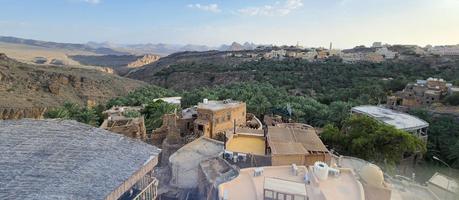
After visiting the Jabrain Castle and the Bahla Fort, we drove through the Jebel Shams range and reached the outskirts of the village later that afternoon.
The Hissen al Misfah Inn in Misfat al Abriyeen Mud Village
We stayed at Hissen al Misfah Inn for the night. To reach the hotel, I had to climb many stairs, some of them narrow and winding. As the mud, stone, and cement steps gave way to tiled steps, I knew I had stepped into the inn.
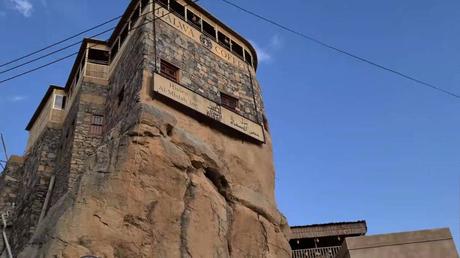
The walls along the stairs were made of mud, adorned with intricately designed ornaments that added more color to the inn.
There was a common room with separate ‘ablution blocks’ for men and women, indicating the presence of rooms for backpackers as well. The room doors had modern handles with intricate designs similar to the ornaments along the way.
The Room
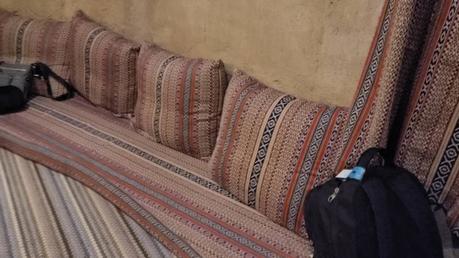
The room had a tiled floor, with an area rug and a beautiful floor cushion in the traditional Omani style. The refrigerator was placed in this area as well.
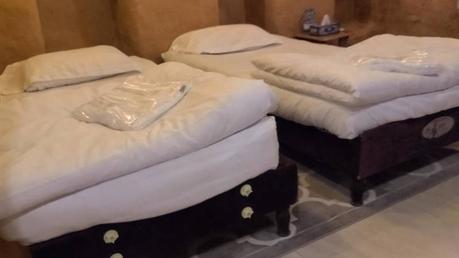
The second half of the room had a raised floor with two beds, all clean with fresh bed linen. The beds were somewhat firm, but I preferred it for the authentic experience.

The room also had a sink, air conditioner, and an attached bathroom with a toilet and shower. One interesting feature was that the walls were made of clay/mud, while the floor was tiled, with dents giving a rustic look.
Meals

Arriving late in the afternoon, we had a buffet-style dinner at the inn, which included rice, pasta, fish, grilled chicken, potato curry, salad, Omani bread, hummus, sweets, and Omani tea. The next morning, the breakfast spread consisted of various types of bread, crepes, dhal curry, sweets, and coffee/tea.
Other Features
One of the highlights of the hotel was the terrace at the top, offering a 360-degree view of the village and beyond. I had a chat with the owner of the hotel, who expressed plans to expand the hotel and its services, given its prime location.
The Misfat al Abriyeen Mud Village
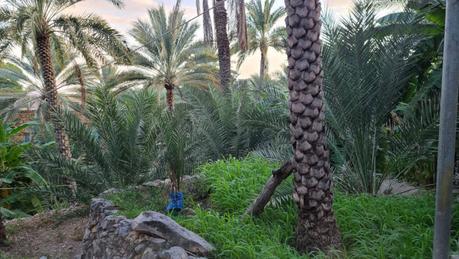
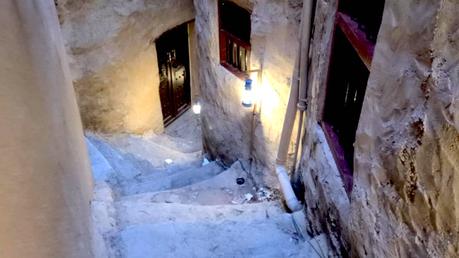
The village itself is a blend of ancient and modern elements. As one climbs the narrow and often winding steps, they will encounter seemingly crumbling stairs and buildings alongside modern abodes. The mostly beige buildings contrast beautifully with the verdant date palms and other trees. While the village may seem maze-like, it adds to the charm and uniqueness of the experience.
The Aflaj Irrigation System
One of the notable features of this village, as well as many others in Oman, is the ancient irrigation system called aflaj (plural for falaj). This system, hundreds or even thousands of years old, carries water from higher elevations through a series of channels to lower lying areas. These channels provide water for livelihoods and farming. In the past, watchtowers were built to protect the channels.
Leaving
After breakfast, it was time to bid farewell to Misfat al Abriyeen and head towards the next destination.
Final Comments
While the mud village may not be a major tourist attraction, it receives a considerable number of visitors. Misfat al Abriyeen remains a village that grapples with preserving its ancient heritage while embracing modernity. Like many other villages, it has also experienced the migration of younger people to urban areas for job opportunities and a more modern lifestyle.
